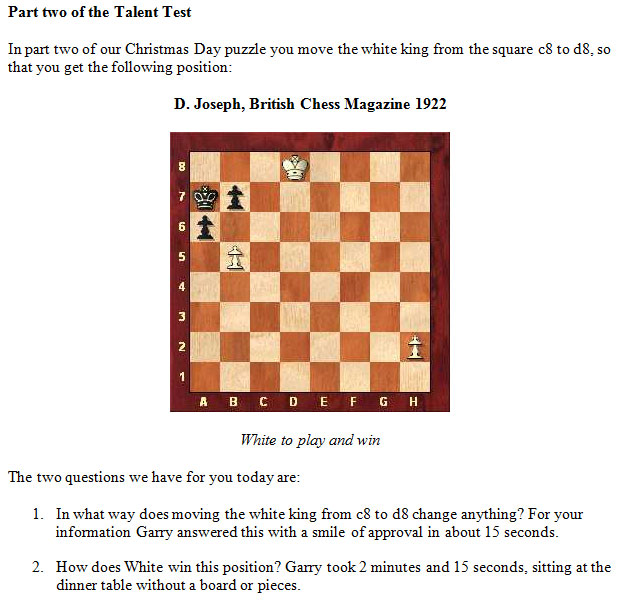A Merry Christmas to all our readers
Or a Happy Christmas if you are British or Irish, or Season's Greetings if you are secular. Our tradition of presenting you with a week of chess puzzles during the Winter Solstice has been going on for sixteen years now and traditionally began on the 25th with an ICQ Christmas greeting.

These are animated Flash greeting cards, and you can watch the above
international Merry Christmas, or Santa's time machine, or this rooftop song.
December 25, 2015: Reviving a famous talent test
By Frederic Friedel
This year we start our problem week with a position we have used before and with which some of you will be familiar. Those readers should bear with us – there are some interesting tests we recently performed which might be worth following. We also discovered that a great number of people – especially young and talented players, had not seen the position before. So we will return to it and report on what we have been up to.
Here is a screen shot of the original Christmas puzzle as we published it fourteen years ago:

We entreat you spend a few minutes working the above position in your mind. Record the time you took to (hopefully) solve the problem. You can then compare your results with those of a few notable players. Only after that should you...

[Event "?"] [Site "?"] [Date "2001.??.??"] [Round "?"] [White "Talent test"] [Black "White to play and win"] [Result "1-0"] [SetUp "1"] [FEN "2K5/kp6/p7/1P6/8/8/7P/8 w - - 0 1"] [PlyCount "11"] [EventDate "1983.??.??"] {The only move to win.} 1. b6+ $1 (1. h4 axb5 2. h5 b4 3. h6 b3 4. h7 b2 5. h8=Q b1=Q {only draws.}) (1. bxa6 {actually loses:} b5 2. h4 b4 3. h5 b3 4. h6 b2 5. h7 b1=Q 6. h8=Q Qb8+ $19) 1... Kxb6 2. h4 a5 3. h5 a4 4. h6 a3 5. h7 a2 6. h8=Q $18 1-0
How Garry Kasparov could not solve this puzzle
That was not so difficult, was it? Well, in 1999 Garry Kasparov failed to solve this position. It happened during the Hannover trade fair CeBit, where the World Champion was a honorary guest and played some games against public personalities, including the German Interior Minister, a popular actor, the East German talent Elisabeth Pähtz, and of course the computer program Fritz.
In the evening there was a gala dinner attended by top industrialist figures, famous personalities, editors of major German newspapers. Everyone was fascinated by the incredible tales of chess skill that surrounded the World Chess Champion, and at one stage I decided to show the guests something dramatic. "Now everybody watch," I announced, "I'm going to ask Garry to solve a chess problem in his mind." Then I dictated the above position to him and, beaming at everyone around the table, asked him for the solution.
Garry frowned, shook his head and said: "Sorry, you gave me the wrong position." Oops, how embarrassing. I dictated it again, slowly and carefully, but Garry still kept shaking his head and muttering "something is wrong." He was incapable of giving the required answer.
What was the explanation? The problem was too easy – he could not understand why I would ask him something as elementary as that. I suppose it is similar to having a world-famous mathematician as our guest and asking him to demonstrate his skills by multiplying the numbers 7 and 3.
"It is part one of a two-part problem, Garry," I said. "Please just give me the solution!" That was of course no problem, and he rattled it off in a disgruntled mutter at high speed. "Okay, now we come to part two," I said, and proceeded with the problem I am now going to share with you – again with an original screen shot from December 2001.

Over the years I have given the problem to many great chess talents and timed them – from five to fifteen minutes to not at all – always without a board or pieces. Please try to solve it first straight off the diagram above. If you do not succeed, get a board and pieces. Make a note of the time you took with or without a board.
Come back tomorrow for the solution and the adventures we had with the Joseph study this year.
Once again apologies to readers who know the position and have read the stories surrounding it. For them we have a special Christmas Day treat, sent to us by our most faithful friend Pal Benko. It is a mate problem that symbolizes a Christmas candle.
Pal Benko, 2015

White to play and mate in five
Not a simple problem, as we can testify. Get a chess board and pieces – they are there in the shelf somewhere – and try to work out the solution. If that fails you can use computer assistance. Naturally you should not post any moves in our feedback section below.




























